Serviços Personalizados
Journal
Artigo
Indicadores
-
 Citado por SciELO
Citado por SciELO -
 Acessos
Acessos
Links relacionados
-
 Citado por Google
Citado por Google -
 Similares em
SciELO
Similares em
SciELO -
 Similares em Google
Similares em Google
Compartilhar
DYNA
versão impressa ISSN 0012-7353versão On-line ISSN 2346-2183
Dyna rev.fac.nac.minas v.77 n.163 Medellín jul./set. 2010
SECONDARY VOLTAGE CONTROL BASED ON ADAPTIVE NEURAL PI CONTROLLERS
CONTROL SECUNDARIO DE VOLTAJE BASADO EN CONTROLADORES NEURONALES ADAPTATIVOS PI
RUBEN TAPIA
Engineering Department, Universidad Politécnica de Tulancingo, Tulancingo, Hgo. MEXICO, rtapia@upt.edu.mx
IVAN RIVAS
Engineering Department, Universidad Politécnica de Tulancingo, Tulancingo, Hgo. MEXICO, irivas@upt.edu.mx
JUAN M. RAMIREZ
Electrical Engineering Department, CINVESTAV - GDL, Zapopan, Jal. MEXICO, jramirez@gdl.cinvestav.mx,
ROSA E. CORREA.G
Desarrollo Tecnológico Industrial, Universidad Nacional de Colombia, recorrea@unal.edu.co
Received for review August 13th, 2009, accepted March 25th, 2010, final version May, 25th, 2010
ABSTRACT: This paper's aim is to present the performance of a B-spline neural network controller to regulate the reactive power provision from synchronous machines. Due to the fact that power systems work with non-stationary parameters and changing settings, adaptive control schemes are preferred. Control technology must ensure its performance in terms of power system's operation to address the diversity of loads and the optimal utilization of the available resources. The B-spline neural network is an efficient tool to implement the adaptive control voltage, with the possibility of carrying out this task on-line taking into account the systems' non-linearities. The reactive power dispatch is based on the premise that each machine must provide a proportion according to its nominal operating capacity. The applicability of the proposal is demonstrated by simulation on a 9-buses 3-machines power system.
KEYWORDS: Neural networks, adaptive PI parameters, on-line training.
RESUMEN: Este trabajo tiene como objetivo presentar el desempeño de un controlador basado en redes neuronales B-spline que regula el aporte de potencia reactiva de las máquinas síncronas. Debido a que los sistemas de potencia operan con parámetros no estacionarios y configuración cambiante, es preferible utilizar esquemas de control adaptativos. La tecnología de control debe asegurar su desempeño en términos de condiciones operativas prácticas de los sistemas de potencia, que considere la diversidad de cargas conectadas a la red y maximice la disponibilidad de recursos. La red neuronal B-spline es una herramienta conveniente para implementar el control adaptativo de voltaje, con la posibilidad de llevar a cabo ésta tarea en-línea considerando las no linealidades del sistema. El despacho de potencia reactiva se basa en la premisa de que cada máquina debe aportar en proporción a su capacidad nominal de operación. La aplicabilidad de la propuesta se demuestra mediante simulación en un sistema de potencia multimáquinas.
PALABRAS CLAVE: Redes neuronales, parámetros PI adaptativos, entrenamiento en-línea.
1. INTRODUCTION
Modern electrical power systems may be subjected to stressing conditions due to the continuous growth in load. In order for consumers to receive reliable electrical power, the system's operators must ensure that bus voltages are kept within allowable limits.
Power transfer from generating plants to consumption centers affects the load bus voltages; therefore, it may be necessary to add elements into the network to provide safer operation [1-2].
Nowadays, in several countries the transmission system's voltage control practice is performed manually. This conventional way of addressing the voltage control problems often exhibits unsatisfactory performances, such as [3]: (i) reactive power generation, (ii) the high side voltage controls, (iii) switching control of banks of capacitors or shunt reactors.
One of the voltage control objectives is to minimize the transmission lines' losses at any time, protecting the system from voltage instability. To meet this goal, an adequate voltage profile under normal operating conditions is required. At the same time, it must be ensured that, under contingencies, all generators dispose of enough reactive power reserves in order to remain at the appropriate settings. Likewise, with the increase in reactive power margins, undesirable reactive power flows are avoided.
Conventionally, voltage and reactive power control in transmission systems have been divided into three levels: (i) primary, (ii) secondary, and (iii) tertiary [3-6].
The primary control is accomplished by the excitation systems.
The objective of the secondary control level is to control the voltage profile in an area or region according to a reference voltage profile. In practice, the secondary voltage control (SVC) does not directly monitor the voltage amplitude at all nodes. The SVC achieves its objective by keeping the pilot nodes at assigned values, and those nodes are in some way representative of the voltage profile of an area or region. On the basis of the voltage variations at the pilot nodes, the SVC generates reference signals for the primary control level as well as for some other voltage control devices, such as on-load tap changers (OLTC) of transformers, which are too slow for use in primary control action [4, 5].
At the tertiary level, coordination between the primary and secondary levels is sought with the purpose of attaining a safer operation [5]. Altogether, the most important task is to maintain the security requirements.
Voltage and reactive power control have been approached using different strategies, such as the pilot node concept for the reactive power regulation [5]. Techniques using optimal power flow have also been proposed [6]. Application of intelligent adaptive control techniques that allow the reactive power provision for different devices installed in the system are presented in [7-9].
This paper focuses to the secondary voltage control. It is assumed that every generator in a central station provides reactive power according to its rating.
The secondary voltage control (SVC) manages multiple power resources by using measurements of one or several pilot nodes. The SVC modifies the reference settings in automatic voltage regulators (AVR), load-tap changers (LTC), or synchronous condensers. The SVC's time response is within 30-100 s.
This way, the SVC consists of pilot nodes' voltage monitoring. It takes charge of the voltage regulation by means of increasing/decreasing the reactive power contribution coming from generating and compensating units.
In this paper, a modern strategy based on neural networks is proposed to carry out secondary voltage control.
2. MODELING
2.1 Power systemIn this paper, a 3-machines 9-buses, Fig. 1, is employed in order to illustrate the proposition. The development of systematic methodologies to pilot nodes allocation is a problem that requires special treatment. Once determined that a power system requires reactive power support, the fundamental problem is the power source location and composition (static or dynamic). The reactive power deficiency may be solved by different means such as the construction of new transmission lines, the installation of new generating units, by FACTS devices installation, and by an appropriate reactive power resources' management. In this paper, bus-5 is chosen as a pilot node, which was selected based on its greatest short circuit capacity.
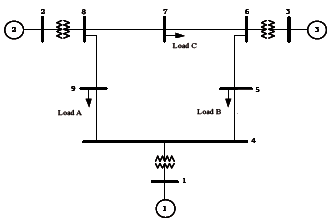
Figure 1. Schematic diagram of the 9-buses 3-machines power system
The generating units are modeled by its fourth order dynamic model, including a static excitation system [1]. The set of equations for each generator becomes:
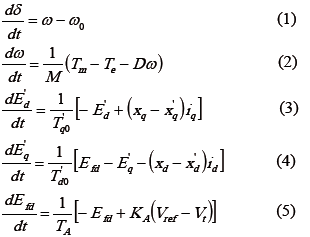
where d (rad) and w (rad/s) represent the rotor angular position and angular velocity; E'd (pu) and E'q (pu) are the internal transient voltages of the synchronous generator; Efd (pu) is the excitation voltage; id (pu) and iq (pu) are the d- and q-axis currents; T'd0 (s) and T'q0 (s) are the d- and q-open-circuit transient time constants; x'd (pu) and x'q (pu) are the d- and q- transient reactances; xd (pu) and xq (pu) are the d- and q- synchronous reactances; Tm (pu) and Te (pu) are the mechanical and electromagnetic nominal torque; M is the inertia constant; D is the damping factor; KA and TA (s) are the system excitation gain and time constant; Vref is the voltage reference; Vt is the terminal voltage magnitude.
2.2 Secondary voltage control strategyThis paper employs the concept of secondary voltage control proposed in [5]. The proposition allows regulating the vars provision for each generator according to its rating. This strategy helps to accomplish an efficient vars injection into the network, handling the reactive flows depending on the load variation. Likewise, the pilot nodes' regulation improves the voltage profile around critical areas.Four proportional-integral (PI) controllers will be utilized: one for each generator plus a central controller, which estimates the reactive power that each generator delivers, Fig 2. The required measurements are: a) reactive power coming from each generator; b) generators' terminal voltage; c) the pilot node voltage magnitude.
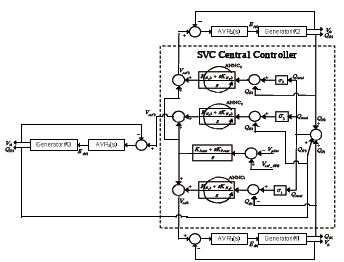
Figure 2. Secondary voltage control scheme
This paper proposes the use of adaptive PI controllers to maintain the reactive power control in each generator, in order to avoid stressing conditions under load variations throughout the day. This can be achieved adding a B-spline neural network to update gains Kp and KI in the three PI controllers, Fig. 2, where each PI transfer function is given by

Thus, Kp and KI are updated from a B-spline neural network at every sampled time. With this purpose, six artificial neural networks (ANN) are assembled in the control scheme, keeping constant the PI gains associated to the pilot node. In Fig. 2, σ1, σ2, and σ3 are weighting factors to share the total reactive power; they are selected according to the generator's rating, Table I [2].
Thus, the appropriate reactive power regulation will provide enough reserve under stressing conditions.
3. NEURAL NETWORK CONTROLLER DESIGN
The controller's design simplicity is one of the major advantages of the artificial neural networks (ANN). The B-spline neural networks (BSNN) are a particular case of neural networks useful for on-line controlling and modeling, taking into account the system's non-linearities.
Some control parameters must be specified, such as the shape of the basis functions, Fig. 3, and the learning rate. Despite the fact that the BSNN structure is specified, it can be adapted to achieve a satisfactory performance over a wide range of operating conditions, since its weighting vector is updated on-line over each sampling time. That is, the BSNN can adaptively be updated for output's tracking when the system's operating point is modified or an external disturbance arises.

Figure 3. BSNN to adapt the PI parameters
Through parameters Kp and KI, the major task of the secondary voltage regulator is to manage the generators' reactive power control and the reference bus voltage in the pilot node, Fig. 3. Signal  is employed to evaluate Kp and KI. ep is the difference between the excitation system reference voltage and the actual generator's terminal voltage. The BSNN's output can be described by [10],
is employed to evaluate Kp and KI. ep is the difference between the excitation system reference voltage and the actual generator's terminal voltage. The BSNN's output can be described by [10],

where wi and ai are the i-th weighting factor and the i-th BSNN basis function output, respectively; p is the number of weights.
The proposed neuro-controller is composed by two BSNNs, one to update Kp and another to update KI. Thus, the networks are described as follows:

where NNm denotes the BSNN which is used to calculate Kp and KI; m = 1, 2, 3 (number of generators); in this case, function NN includes one weight w1.
In this paper, the neuro-controller is trained on-line using the following error correction instantaneous learning rule [10],

where η is the learning rate and ei(t) is the instantaneous output error.
In this paper, the neural network controllers, (8)-(9), are designed by univariate basis functions of order 3, considering that ep are bounded within [-1.5, 1.5] pu [10].
Respect to the learning rate, it takes as initial value one point within the interval [0, 2] due to stability purposes [10]. This value is adjusted by trial-and-error; with a value close to zero the training becomes slow. However, if such value is large, oscillations can occur; in this application it settles down in 0.025.
The instantaneous training rules provide an alternative so that the weights are continually updated and reach the convergence to their optimal values. The neural nets with on-line training exhibit attractive characteristics with respect to other nets [11].
4. RESULTS
The power system in Fig. 1 is studied in order to prove the performance and robustness of the proposed control scheme. To analyze the results, simulations are developed under different scenarios: a) with a conventional PI control (CONV); b) with an adaptive PI parameters scheme. Three operating conditions are taken into account. The conventional PI parameters remain without change for all cases studied, while in the case of the adaptive parameters, these are updated on-line.
4.1 Case 1To validate the neuro-controller's performance, different disturbances are simulated. In this first case, the system operates at its nominal condition [2], while is subjected to a three-phase fault in bus-8 lasting for 100 ms. After the fault is cleared, the system get back to its initial configuration. Figs. 4-6 display the evolution of some significant signals. Table II presents the generators' reactive power respect to their nominal capacity. Notice that, at steady state, the delivered vars are quite close to the expected, thanks to the secondary voltage scheme. Fig. 4 shows the dynamic performance of generator-3 reactive power; the voltage magnitude on the faulted bus is presented in Fig. 5; Fig. 6 shows the PI gains evolution attained through the adaptive neural network scheme.
Table II. Reactive power proportions.
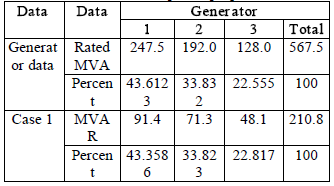
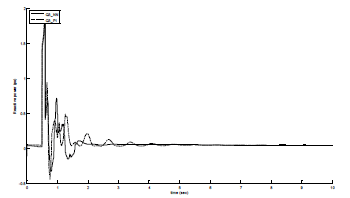
Figure 4. Generator-3 reactive power performance, case 1
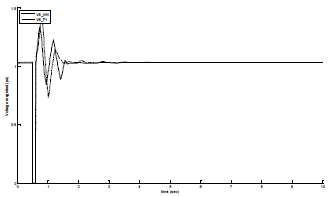
Figure 5. Bus-8 voltage response, case 1
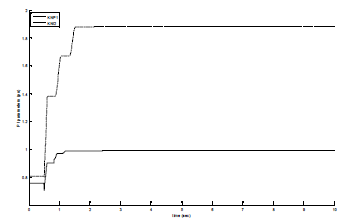
Figure 6. Adaptative PI parameters evolution for case 1
Results exhibit a satisfactory performance of the BSNN PI parameters, showing better characteristics that the conventional (CONV) control technique, especially those related with overshoots and settling times. Likewise, the bus-8 voltage goes back to the reference value. According to the grid evolution, the PI parameters are updated, Fig. 6. When the power system reaches the steady state these parameters remain without change.
4.2 Case 2This case illustrates the system evolution when at t = 0.5 s a three-phase fault on bus-8 is simulated lasting for 83 ms. Line 8-9 is tripped to clear the fault. Figs. 7-9 depict the reactive power and bus-8 voltage magnitude, and angular difference d31 behavior, where satisfactory coordinated performance can be appreciated.
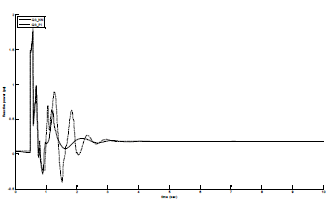
Figure 7. Generator-3 reactive power performance, case 2
The BSNN has the ability to adapt itself to this new operating condition, improving the conventional PI performance. These controllers give rise to reactive power oscillations, Fig. 7. On the other hand, by updating the PI parameters the oscillations are diminished.
Fig. 5 presents satisfactory performance for both control schemes. However, in Fig. 8 it is obvious that the performance of the conventional PI controller is poorer than that of the BSNN. The voltage profile in the neighboring buses is improved by secondary voltage control exhibiting better dynamic performance when BSNN is included. Fig. 9 displays the angular difference 3-1, which exhibits positive interaction between the BSNN and system's evolution.
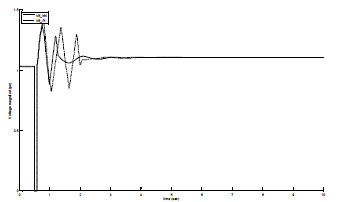
Figure 8. Bus-8 voltage response, case 2
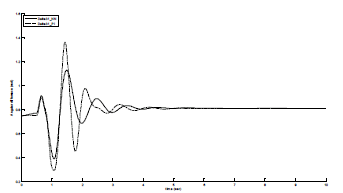
Figure 9. Angular difference d31, case 2
This case illustrates the system evolution when at t = 0.3 s the pilot node reference is increased to 1.02 pu. Figs. 10-11 display the system behavior.
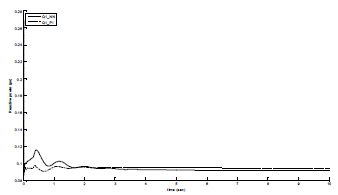
Figure 10. Generator-1 reactive power performance, case 3
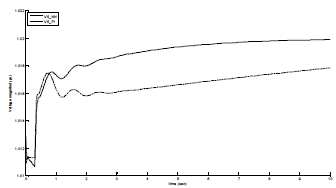
Figure 11. Bus-5 pilot node response, case 3
Fig. 10 depicts the dynamic performance of generator-1 reactive power; the pilot node voltage magnitude is presented in Fig. 11. The response with BSNN is better than that utilizing conventional PI, since in the latter case a slower response and a steady state error is noticeable.
The performance of both control techniques is in accordance with case 1 and 2. The BSNN exhibits better performance adapting itself easily to the new circumstances. This helps to maintain the operation within safer regions, preventing from an instability scenario.
5. CONCLUSIONS
This paper proposes the inclusion of B-Spline neural networks to update the PI controller parameters in charge of the secondary voltage control in power plants. The performance and applicability of the proposition are proved by digital simulation on a 9-buses 3-machines power system. This strategy allows controlling appropriately the pilot node voltage magnitude, but also it not affects oscillations and overshoots in relevant signals. The feedback signals utilized for the BSNN are pertinent for suitable secondary voltage control exhibiting a positive interaction with the system.
The BSNN controllers are compared to conventional PI controllers. While the neural controller is able to adapt itself to different operating conditions, the conventional controllers' performance tends to be poorer under such circumstances.
ACKNOWLEDGMENT
Rubén Tapia, Iván Rivas, and Juan M. Ramirez express gratitude to PROMEP and CFE-CONACyT under grant 88160.
REFERENCES
[1] TAYLOR, C. W., Power System Voltage Stability, McGraw-Hill, 1993. [ Links ]
[2] Anderson, P. M., Fouad, A. A. Power System Control and Stability, IEEE Press, 2d ed., 2003. [ Links ]
[3] TAYLOR, C. W., Line drop compensation, high side voltage control, secondary voltage control - why not control a generator like a static var compensator?, IEEE Summer Meeting 2000, vol. 1, pp 307-310. [ Links ]
[4] Noguchi, S., Shimomura, M., Paserba, J., Improvement to an advanced high side voltage control, IEEE Trans. on Power Systems, vol. 21, No. 2, pp 683 - 692, 2006. [ Links ]
[5] Corsi, S., The secondary voltage regulation in Italy , Panel session on secondary voltage control IEEE Summer Meeting, 2000. [ Links ]
[6] Miguelez, E.L., Cerezo, F.M.E., Rodriguez, L.R., On the Assignment of Voltage Control Ancillary Service of Generators in Spain, IEEE Trans. on Power Systems, vol. 22, No. 1, pp 367 - 375, 2007. [ Links ]
[7] Marques, A.B., Taranto, G.N., Falcao, D.M., A knowledge-based system for supervision and control of regional voltage profile and security, IEEE Trans. on Power Systems, vol. 20, No. 1, pp 400 - 407, 2005. [ Links ]
[8] Fusco, G., Russo , M., Adaptive voltage regulator design for synchronous generator, IEEE Trans. on Energy Conversion, Vol. 23, No. 3, pp 946-956, 2008. [ Links ]
[9] Gehao Sheng, Xiuchen Jiang, Dapeng Duan, Guangyu Tu, Framework and implementation of secondary voltage regulation strategy based on multi-agent technology, International Journal of Electrical Power and Energy Systems, vol. 31, No. 1, pp 67-77, 2009. [ Links ]
[10] Brown, M., Harris, C. J., Neurofuzzy Adaptive Modelling and Control, Prentice Hall International, 1994. [ Links ]
[11] TANG, K.W., Instantaneous Learning Neural Networks, [Ph.D. Thesis], Louisiana State University, 1999. [ Links ]















